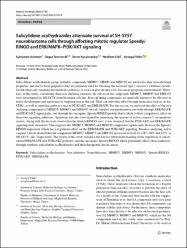| dc.contributor.author | Arzıman, Süleyman | |
| dc.contributor.author | Tanrıverdi, Özgür | |
| dc.contributor.author | Küçükvardar, Seren | |
| dc.contributor.author | Çitil, Neslihan | |
| dc.contributor.author | Yıldız, Ayşegül | |
| dc.date.accessioned | 2020-11-20T14:39:23Z | |
| dc.date.available | 2020-11-20T14:39:23Z | |
| dc.date.issued | 2020 | |
| dc.identifier.issn | 1357-0560 | |
| dc.identifier.issn | 1559-131X | |
| dc.identifier.uri | https://doi.org/10.1007/s12032-020-01391-9 | |
| dc.identifier.uri | https://hdl.handle.net/20.500.12809/403 | |
| dc.description | WOS: 000550232200001 | en_US |
| dc.description | PubMed ID: 32691165 | en_US |
| dc.description.abstract | Salicylidene acylhydrazide group synthetic compounds ME0053, ME005 and ME0192 are known for their iron chelating properties and due to these properties they are primarily used for blocking the bacterial type 3 secretory virulence system. On the other side, targeting the metabolic pathways of iron can provide new tools for cancer prognosis and treatment. Therefore, in this study, considering their iron chelating function, the effects of the compounds ME0053, ME0055 and ME0192 were investigated in SH-SY5Y neuroblastoma cell line. Iron chelating compounds are generally known to be effective in tumor development and metastasis by targeting iron in the cell. They can exert this effect through molecules such as cyclin, CDKs, as well as signaling pathways such as PI3K/AKT and ERK/MAPK. For this reason, we analyzed the effect of the iron chelating compounds of ME0053, ME0055 and ME0192 on cell viability and proliferation rate both through ERK/MAPK and PI3K/AKT signal paths, and through the oncogenic Speedy/RINGO protein that is likely to have a regulatory effect on these two signaling pathways. Apoptosis was also investigated by measuring the amount of active caspase-3, an apoptotic marker. Along with the decrease observed in the Speedy/RINGO level, it was observed that the PI3K/AKT and ERK/MAPK signaling were decreased. This suggests that ME0053, ME0055 and ME0192 compounds significantly decrease the Speedy/RINGO expression which has a regulatory effect on the ERK/MAPK and PI3K/AKT signaling. Besides, analyzing active caspase-3 levels showed that the compounds ME0053, ME0055 and ME0192 increased its level by 218%, 60% and 175% in SH-SY5Y cells, respectively. The results of this study will pave the way for better understanding of the regulation of cancer-related ERK/MAPK and PI3K/AKT pathways and the oncogenic Speedy/RINGO which potentially affects these pathways, through synthetic salicylidene acylhydrazides and their therapeutic use in cancer. | en_US |
| dc.description.sponsorship | Mugla Sitki Kocman University Scientific Research Project Office, Research and Development ProjectsMugla Sitki Kocman University [17/251, 17/023] | en_US |
| dc.description.sponsorship | This study was supported by grant to Aysegul Yildiz from Mugla Sitki Kocman University Scientific Research Project Office, Research and Development Projects (Project Numbers: 17/251 and 17/023). We sincerely thank Prof. Dr. Uygar Halis Tazebay from Gebze Technical University, Department of Molecular Biology and Genetics and Prof. Dr. Arzu Karabay Korkmaz from lstanbul Technical University, Faculty of Science and Letters, Molecular Biology and Genetics Department for allowing us to use their laboratory infrastructure. We would also thank Assoc. Prof. Emin Ilker Medine from Ege University Institute of Nuclear Sciences for his help about providing SH-SY5Y neuroblastoma cell line and to Prof. Dr. Mikael Elofsson from Umea University for providing all the salicylidene acylhydrazide compounds used in this study. | en_US |
| dc.item-language.iso | eng | en_US |
| dc.publisher | Humana Press Inc | en_US |
| dc.item-rights | info:eu-repo/semantics/openAccess | en_US |
| dc.subject | Salicylidene Acylhydrazides | en_US |
| dc.subject | Iron Chelation | en_US |
| dc.subject | Neuroblastoma | en_US |
| dc.subject | Speedy | en_US |
| dc.subject | RINGO | en_US |
| dc.subject | PI3K | en_US |
| dc.title | Salicylidene acylhydrazides attenuate survival of SH-SY5Y neuroblastoma cells through affecting mitotic regulator Speedy/RINGO and ERK/MAPK-PI3K/AKT signaling | en_US |
| dc.item-type | article | en_US |
| dc.contributor.department | MÜ, Fen Fakültesi, Moleküler Biyoloji ve Genetik Bölümü | en_US |
| dc.contributor.department | MÜ, Tıp Fakültesi, Dahili Tıp Bilimleri Bölümü | |
| dc.identifier.doi | 10.1007/s12032-020-01391-9 | |
| dc.identifier.volume | 37 | en_US |
| dc.identifier.issue | 8 | en_US |
| dc.relation.journal | Medical Oncology | en_US |
| dc.relation.publicationcategory | Makale - Uluslararası Hakemli Dergi - Kurum Öğretim Elemanı | en_US |


















